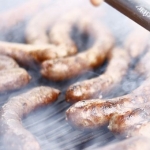Last week we wrote about the food served up at the recent TEDx Sydney, and Mrs Sarantides meatballs. This week we’re cooking up a huge batch of sausages to feed the ravening hordes.
The FIVE THOUSAND tasty pork and veal sausages made by Feather and Bone started with a recipe from the SLM collections, published in one of the Rouse family cookery books – Domestic Cookery, for the use of private families, authored by ‘A Lady’, Mrs Maria Rundell. Printed in 1864 the book is, in fact, a much older text, a direct reprint of the 1816 edition. Rundell died in 1828, so the reprint demonstrates the longevity of a cookery text in the C19th century, and the wiliness of publishers back in the day to stick with a good thing. (Mrs Beeton books have a similar story, being published well into the C20th century though the author herself died in 1865).
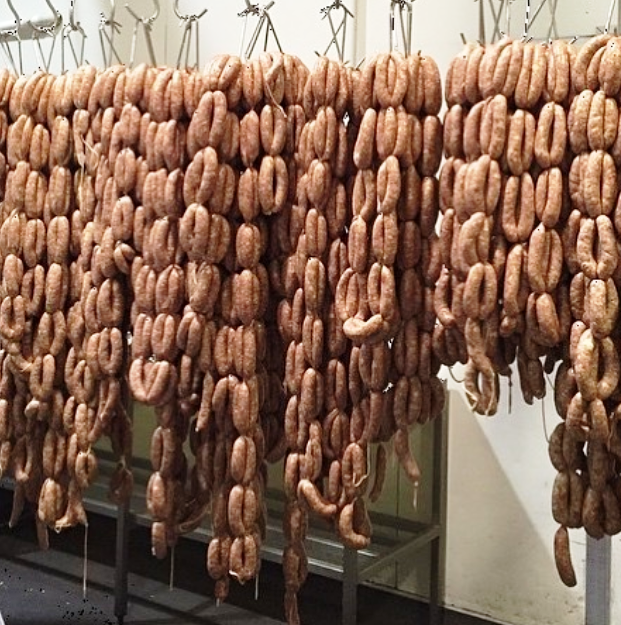
Sausages made by Feather and Bone for TEDxSydney 2016. Photo © Feather and Bone.
Sausages.
Chop fat and lean pork together; season it with sage, pepper, and salt, and you may add two or three berries of allspice: half fill hog’s guts that have been soaked and made extremely clean; or the meat may be kept in a very small pan, closely covered; and so rolled and dusted with a very little flour before it is fried.
Serve on stewed red cabbage; or mashed potatoes put in a form, brown with salamander, and garnish with the above; they must be pricked with a fork before they are dressed, or they will burst.
Domestic Cookery, for the use of private families. Maria Rundell, 1864.
Yes you read that correctly – ‘Hog’s guts’
One of Mrs Rundell’s cookbook’s charms is that she originally wrote it for her own daughters, so her recipes often include personal insights and tips, such as pricking the sausages so that their skins won’t burst – though this is a highly contested practice these days. The hog’s guts she refers to are the animal’s intestines which traditionally form the sausage skin in so many cultures. Some butchers will supply them – ready cleaned thank goodness – but fear not, if you don’t fancy dealing with them, Mrs Rundell’s recipe (above) includes a skinless, rissole-like version of the meat mix rolled in a little flour which you might prefer to try at home.
An ancient art
Sausages are an ancient method of cookery found all over the world, made either with or without the skin, and that make it easy to use up all the small, awkward bits of leftover meat (or hide them!). With some methods, such as smoking, they can also be used as a method pf preserving meat for quite a long time. Apicius the ancient Roman author gives several sausage recipes, the best known is this one for ‘Lucanian sausage’, which sounds rather delicious:
Lucanian sausage or meat pudding are made similar to the above: crush pepper, cumin, savory, rue, parsley, condiment, laurel berries and broth; mix with finely chopped fresh Pork and pound well with broth. To this mixture, being rich, add whole pepper and nuts. When filling casings carefully push the meat through. Hang sausage up to smoke.
Apicius, De Re Coquinaria, II:iv [1]
Another recipe is for a sausage of chopped egg, onion, leek and spices, cooked (ie poached) in stock and wine. Did you note the total lack of measurements or precise method? As we’ve discussed before, these details don’t really appear in English cookbooks until the mid 19th century.
A total farce?
Johnson in his famous dictionary (1755) defined a sausage as:
Sáusage. n.s. [saucisse, French; salsum, Latin.] A roll or ball made commonly of pork or veal, and sometimes of beef, minced very small, with salt and spice; sometimes it is stuffed into the guts of fowls, and sometimes only rolled in flower.
‘The guts of fowls’ suggests a rather small diameter sausage indeed, although Johnson is more likely to be referring to sausage meat being used as a stuffing or ‘forcemeat’ for poultry – which Eliza Acton [1845] defines: “Forcemeat means stuffing, having been Anglicized from the French word ‘Farce'”.
All ready? Then lets get stuffing!!
While the vast number of sausages were being cooked downstairs by the TEDxSydney caterers, Grant from Feather and Bone was demonstrating how to make sausages using intestine skins and a hand tuned sausage press for a fascinated crowd at a stand in the north foyer.
First the skins are slid onto the press nozzle:
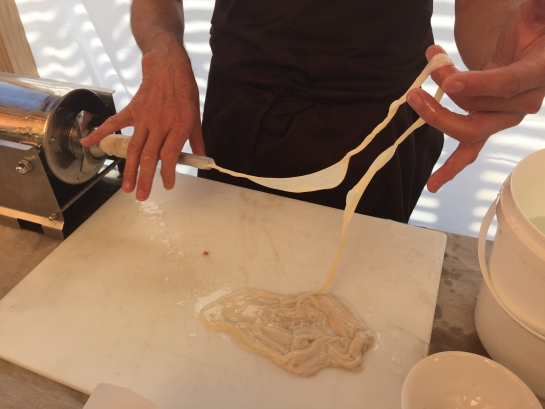
Loading the skin onto the nozzle. Photo (c) Scott Hill for Sydney Living Museums
Then the meat is pushed into the skins, making one long sausage. This press works by a hand crank at the back; its a skill to keep the pressure even so that the stuffing is consistent:

Stuffing the sausages. Photo (c) Scott Hill for Sydney Living Museums
This gives you one, very long sausage, like a South African ‘Boerewors’:
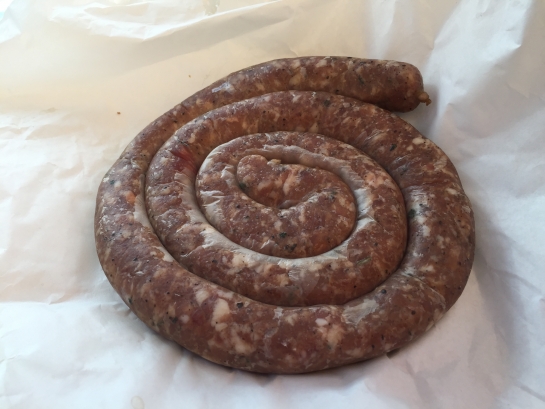
Untwisted sausage length. Photo (c) Scott Hill for Sydney Living Museums
The sausage is then twisted to divide it into individual sausages, in bundles of 5:
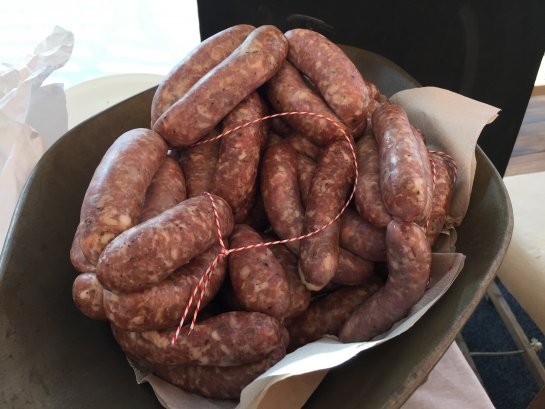
Ready to be cooked. Photo (c) Scott Hill for Sydney Living Museums
What was particularly nice about these sausages was that they were far from the standard store-bought sausage with its suspiciously uniform and oddly smooth texture – typically designed to hide its ingredients as Grant points out. Because the ingredients – the pork, allspice and seasoning of Rundell’s recipe with veal added – were coarsely ground the flavours and textures of each could be distinguished. This isn’t pate after all! While older texts note the use of a mortar and pestle to grind and break up the meat, or say to shop it very finely (think of the impressive way Chinese cooks use a pair of cleavers to create mince) the kitchen at Rouse Hill was equipped with a hand operated mincer which could be clamped onto a table or bench top.
Bon appetite!
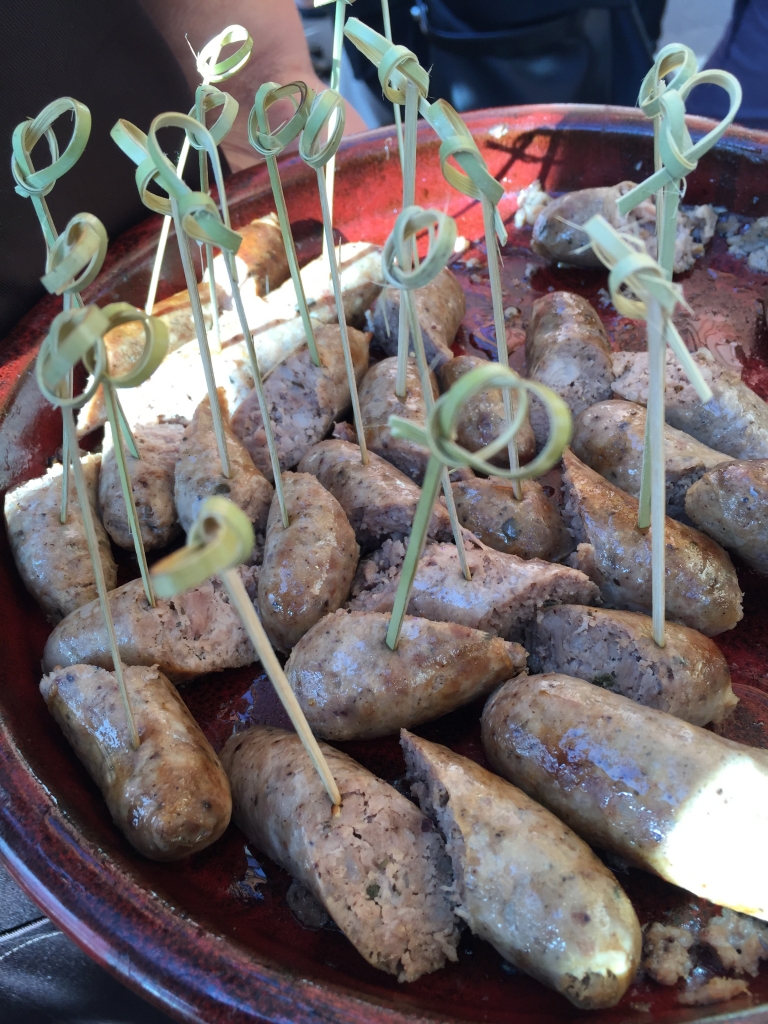
Sausages ready for the ravenous TEDx hordes. Photo (c) Scott Hill for Sydney Living Museums
And a cooks tip ~
Are you cooking a huge number of sausages for a barbecue? To save time, and so that you can serve them all at once, poach the sausages first. (Just don’t overcook them!) Apicius’s work says to poach most of the sausages before frying them.
Notes
[1] The recipe for Lucanian sausage and others recorded by Apicius can be found here.


